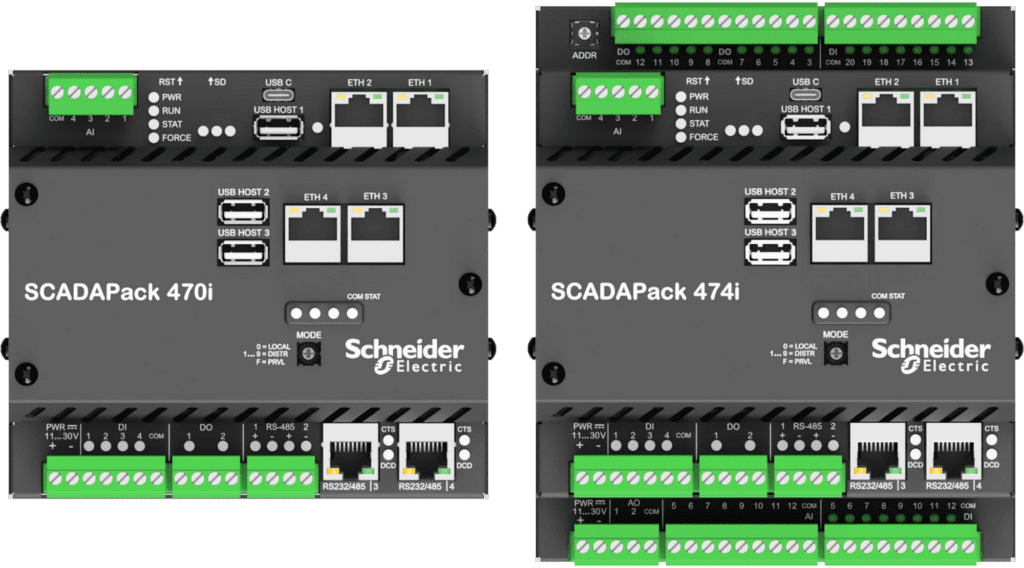< Product News
Enhanced RTU and Controller With Integrated Edge Platform Launched – SCADAPack™ 470i and 474i
September 16, 2024Controlling and monitoring assets in remote operations is a significant challenge for industries like wastewater and energies and chemicals. Remote operations encompass the control and monitoring of assets distributed throughout large geographical areas. These areas may be rural and can be in a harsh environment (e.g., polar, desert, tropical or more). They include locations with limited or no cellular service where other forms of communication are used to transmit information from remote terminal units (RTUs) to their supervisory control and data acquisition (SCADA) system.
Normally, maintaining and servicing an area containing multiple remote assets requires an on-hand technician with direct access to the SCADA system to effectively monitor the status of the facilities. But now, through Schneider Electric’s SCADAPack™ 470i and 474i Smart RTUs, remote assets can be controlled and monitored from anywhere using at-hand devices like laptops or smartphones.
With this new solution, the remote asset operators will be able to simplify the design of their telemetry network. SCADAPack can be used as a data concentrator, impressing the data from remote sites onto a smaller package that could be communicated over data radios. But this is only the beginning of this solution’s capabilities.
Open in every aspect of the word
To help increase energy efficiency and enable autonomous remote system maintenance, Schneider took an open approach with this RTU. We combined a real-time operating system (RTOS) with a Linux-based applications processor. This way, the SCADAPack 470i and 474i provide a dedicated platform for advanced edge computing services and protocols. These capabilities mean that the SCADAPack 470i and 474i are open to legacy and next-generation solutions.

RTOS provides the legacy capability companies need and expect from an RTU and programmable logic controller (PLC). It also enables the critical performance needed for monitoring inputs and outputs for control of instrument communications, in addition to support for the legacy telemetry protocols, as well as for IEC 61131-3 logic.
We also wanted to make this solution open in terms of where it can be deployed. The new SCADAPack series can operate across a wide temperature range, from minus 40 degrees to 70 degrees Celsius, as well as high levels of humidity, vibration and shock.
By drawing on more sources of information, better decision-making occurs in whatever industry the control application is being used in. This includes production automation and optimization in the form of pump automation, leak detection, analytics, and a slew of applications. The information is gathered from the site, combining with information from other sources, like the cloud or a SCADA system.
The immediate detection and reporting of any abnormalities from these remote sites, and the ability to automatically make corrections, is what this type of IoT technology is evolving towards.
Centralized RBAC to harden against cyberattacks
When it comes to critical infrastructure and pipelines, cybersecurity threats have evolved from affecting IT to include OT systems. Legacy OT systems are vulnerable and don’t interface with standard tools traditionally. Over the past few years, we’ve seen a few examples of this vulnerability. For instance, there’s the Colonial Pipeline ransomware attack, the compromised SCADA systems in a U.S. water treatment facility in Oldsmar, Florida, and, more recently, the exploitation of wastewater system PLCs in Aliquippa, Pennsylvania.
Today, regulations are forcing authorities, responsible for critical infrastructure such as pipelines and water wastewater, to increase their cybersecurity posture. Larger companies also recognize the threat to their business continuity and their share value. This is a challenge that IT-ready, role-based access control in SCADAPack 47xi addresses.
With the addition of role-based access control (RBAC) to SCADAPack, IT or OT security can leverage tools they’ve already invested in. This includes directory services tools like Active Directory and privileged access management (PAM) solutions such as CyberArk® or Solarwinds®. Implementing IT-compatible RBAC simplifies and streamlines implementation of security for OT users. Additionally, it satisfies regulatory requirements with minimum cost and effort. Users can control access to OT equipment across the network as easily as managing an employee’s email access.
Employing networkwide RBAC in RTUs is a powerful way to centralize, derisk, and ease maintenance. Incorporating a centralized RBAC into SCADAPack allows for scaling and is hardened for risk, enabling OT security and IT to:
- Mix and match privileges
- Change configurations
- Assign RTUs to groups
- Geographically control access
Why Linux makes all the difference
Security features are weaved into the core of these new RTUs, from conception to design and through implementation, runtime and communications. Indeed, the SCADAPack 470i and 474i conform to IEC 62443 SL1 cybersecurity standards. There’s flexibility for users to implement those security features in their solutions quickly and easily. Additionally, the RTU still can perform core operations once they have access to it. A secure boot chain helps to prevent tampering with the SCADAPack itself.
Incorporating RTOS means sophisticated decision-making using various sources of information is done in real-time.
For example, if you have a set of pumps used for a contract with an electrical company for power spot prices, we have the ability now to draw real-time cost information to, say, slow down a pump during power spikes. These small, cost-saving practices go a long way, especially if utilities ask companies to minimize operations. Another example might be sensing undesired mixtures in an oil pipeline and adjusting a separator accordingly.
Flexibility around communication serves as an immediate benefit. But the capabilities of smart assets — IIoT-enabled products imbued with machine learning or artificial intelligence — is the future of process automation.
SCADAPack RTUs offer better edge capabilities
This marriage of Linux-based application processor with RTOS paves the way for more resilient and efficient remote operations for many years to come. It provides a dedicated platform for advanced edge services, data, protocols, and applications. It does this while addressing IT and cyber-driven requirements.
These and other components will extend the life of any remote operations, aiding the digital transformation journey and IT-OT convergence. It also supports your current, as well as future, needs in a single rugged device.
To learn more about SCADAPack 470i and 474i and how it can have a profound impact to the resiliency of your operations and efficiency of your workforce, visit the SCADAPack website.
